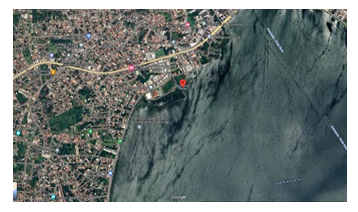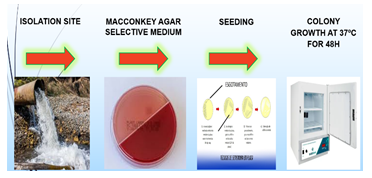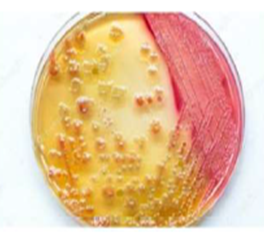Detection of multiresistant Gram-Negative bacteria associated with the irrational disposal of Pharmaceutical Chemical Waste, establishing environmental toxic impact on aquatic ecosystems in Araruama- RJ
Article Information
Cathia Delmaschio2, Priscila de Oliveira Lima Gondim2., Felipe Porto2, Emília Tostes Padilha Gonçalves2, Fellipe de Oliveira Cabral1, Yuri Vieira Faria1, Grazielly Ribeiro Viana4, Luciano Carvalho Rapagnã2, Higor Franceschi Mota1, 2, Givaldo Viana da Silva3, Gilson Viana da Silva2, Ana Luiza de Mattos Guaraldi1, Cassius de Souza*, 1, 2
1Universidade do Estado do Rio de Janeiro, Rio de Janeiro/Laboratório de Difteria e Corinebactérias de Relevância Clínica/Departamento de Microbiologia, Imunologia e Parasitologia da Faculdade de Ciências Médicas da Universidade do Estado do Rio de Janeiro, LDCIC / FCM / UERJ, Rio de Janeiro, Brasil;
2Faculdade da Região dos Lagos, Instituto de Ciências da Saúde/Disciplina de Toxicologia/Laboratório Multifuncional I/FERLAGOS, Cabo Frio, RJ, Brasil;
3Universidade de Guarulhos – SP – Mestrado em Analise Geoambiental, UNG.
4Centro Universitário do Espírito Santo – UNESC – Colatina-ES
*Corresponding author: Cassius de Souza, Disciplina de Microbiologia e Imunologia. Faculdade de Ciências Médicas, Universidade do Estado do Rio de Janeiro. Av. 28 de Setembro, 87 - Fundos, 3° andar. Vila Isabel, RJ, Brazil
Received: 18 April 2023; Accepted: 27 April 2023; Published: 10 May 2023
Citation:
Cathia Delmaschio, Priscila de Oliveira Lima Gondim., Felipe Porto, Emília Tostes Padilha Gonçalves, Fellipe de Oliveira Cabral, Yuri Vieira Faria, Grazielly Ribeiro Viana, Luciano Carvalho Rapagnã, Higor Franceschi Mota, Givaldo Viana da Silva, Gilson Viana da Silva, Ana Luiza de Mattos Guaraldi, Cassius de Souza. Detection of multiresistant Gram-Negative bacteria associated with the irrational disposal of Pharmaceutical Chemical Waste, establishing environmental toxic impact on aquatic ecosystems in Araruama- RJ. Archives of Microbiology and Immunology. 7 (2023): 62-64.
View / Download Pdf Share at FacebookAbstract
Chemical residues, including those of pharmaceutical origin, are disposed of irrationally and inappropriately by a large part of society in inappropriate places such as common garbage, septic tanks, rainwater networks and sewers, becoming a major environmental and social problem, exerting direct consequences on aquatic ecosystems. Different studies have established the possibility of the appearance of biological, toxic and physiological alterations in several niches of living beings that inhabit the aquatic ecosystem, mainly in fish, crustaceans and bacteria. Many of these studies also associate the emergence of bacteria from these ecosystems with resistance to antibiotics. In this way, the evidence is accompanied by the imminent urgency of measures aimed at reducing or interrupting the irrational exposure of Pharmaceutical Chemical Waste (QRF) by the population. Therefore, the objective of this work was to detect the presence of Gram-negative bacilli (GNB) with potential for human and animal colonization and/or infection in this area, analyzing their antimicrobial resistance in the tributaries of Lagoa de Araruama, in the State of Rio de Janeiro. of January. For this purpose, we collected aliquots of 50ml of water, in November 2021, in the Mataruna river, which contributes to the formation of the lagoon, in the central region of the city. In the isolation of the strains, we used selective media for Gram-negative Bacteria MacConkey Agar (AM), supplemented with 32µg/ml cephalothin, 10U/ml penicillin and 2µg/ml clindamycin. Three Swabs moistened with the aliquot taken from the pond were seeded in AM culture plates supplemented with antibiotics, then these plates were placed in an oven at a temperature of 37ºC for 48 hours. Interestingly, as a result, we found more than 20 colonies with distinct colors that grew even in the presence of different classes of antimicrobials, suggesting that they are colonies of multiresistant Gram-negative bacteria, since the MacConkey Agar medium is selective. These data reinforce the problem raised, directing that the presence of chemical agents, including the drugs in question, may be enabling the existence and strengthening of resistant GNB in the lagoon ecosystem. New tests are needed to identify and assess susceptibility to other antibiotics, as there is a possibility that some of these colonies have potential for multidrug resistance in addition to causing serious infections in humans. Therefore, society, especially the population of Araruama, needs awareness and clarification about the dangers and toxic environmental consequences of the irrational exposure of chemical substances in the marine ecosystem.
Keywords
Disposal, Pharmaceutical Chemical Waste, Environment
Disposal articles, Pharmaceutical Chemical Waste articles, Environment articles
Article Details
1. Introduction
Pharmaceutical chemical residues (RQF) are commonly discarded by industries and the population in an inadequate way in the environment. Many medicines, including antibiotics, are discarded irrationally, by a large part of society, in inappropriate places such as common garbage, septic tanks, rainwater networks and sewers, becoming a major environmental problem and with direct consequences on aquatic ecosystems [1, 3, 7]. Infectious diseases require the use of antimicrobial agents as treatment, however, the inappropriate use combined with the irresponsibility of the disposal of chemical agents, including drugs, driven by the ease of acquisition, is a major concern worldwide. Antibiotics and other drugs are among the most common chemical agents found in the soil of aquatic environments [7]. These medications are often indicated unnecessarily [6]. Currently, the indiscriminate use of antimicrobials has been considered the third biggest public health problem, favoring the development of resistance and dissemination mechanisms of several commensal and pathogenic bacterial species for humans and animals. in species of fish and other marine animals, there is even a strengthening and increase in reports of resistance to antibiotics associated with bacteria present in the aquatic environment [2, 7]. promote measures aimed at reducing or interrupting the irrational exposure of chemical agents and medicines by the population. Therefore, the objective of this work was to detect the presence of Gram-negative bacilli (GNB) multiresistant (MDR) with potential for human and animal colonization and/or infection in this area, analyzing their resistance to antimicrobials, in the tributaries of Lagoa de Araruama, in the State from Rio de Janeiro (Figure 1).
2. Methodology
Using the necessary personal protective equipment (PPE), 50ml of water was collected in November 2021 from the Mataruna River, which contributes to the formation of the lagoon, in the central region of the city. In the isolation of the strains, we used selective media for Gram-negative Bacteria MacConkey Agar (AM), supplemented with 32μg/ml cephalothin, 10U/ml penicillin and 2μg/ml clindamycin. Three Swabs moistened with the aliquot taken from the Mataruna river were seeded in AM culture plates supplemented with antibiotics, then these plates were placed in an oven at a temperature of 37°C for 48 hours (Figure 2).

Figure 1: Image of the Mataruna River, characterizing the social expansion around it.
Source: Google maps 2022

Figure 2: Legends: Presentation of the procedures carried out during the work.
Source: Nogueira, 2015
2. Results
More than 20 colonies with different colors were detected and that grew even in the presence of different classes of antimicrobials (figure 3), suggesting that they are colonies of multiresistant Gram-negative bacteria, since the MacConkey Agar medium is selective. These data reinforce the problem raised, directing that the presence of chemical agents, including drugs such as antibiotics, may be enabling the or a appearance and strengthening of resistant Gram-negative bacteria in the ecosystem in the Mataruna river, affluent of Lagoa de Araruama.

Figure 3: Legends: Photo of the MacConkey contaminated with gram negative bacteria (freepik.com).
3. Discussion
Chemical residues, including those of pharmaceutical origin, are disposed of irrationally and inappropriately by a large part of society in inappropriate places such as common garbage, cesspools, rainwater networks and sewers, becoming a major environmental problem and with direct consequences on In aquatic ecosystems, these chemical agents of pharmaceutical origin have been discarded irresponsibly by society, both in residential and industrial environments [1, 3, 7].
Different studies have established the possibility of the appearance of biological and physiological alterations in several niches of living beings that inhabit the aquatic ecosystem, mainly in fish, crustaceans and bacteria, and our data reveal the possibility of RQF favoring the presence of MDR bacteria in the Mataruna River, promoting an irrecoverable alteration for these aquatic environments [7].
The Mataruna River is surrounded by a dense population mass (figure 1) that apparently dumps its discarded waste directly into the feeder tributaries of the Araruama lagoon. Suggesting that irresponsible and inappropriate disposal may be influencing the biological profile of aquatic beings living in this ecological niche.
The irrational use of drugs, such as antimicrobials and other agents, are common practices and emphatically not tolerated by pharmacists, biologists and other health professionals. Not only because of the different harms they can cause to the individual, but also because of any movement against nature and its dependents [1, 3, 7].
Additionally, the appearance of Gram-negative MDR bacteria presents itself as another extremely negative impact on society, since the favoring and sharing of resistance genes and characteristics can establish great difficulty in combating community and hospital infections [8]. In a chain, in addition to infections that are increasingly difficult to control, there is the need to use even more potent and expensive drugs, causing more damage to the financial health of public and private bodies.
4. Conclusion
The presence of multiresistant strains isolated from the Mataruna River in the city of Araruama in the Lagos Region of Rio de Janeiro should serve as a warning to sanitary and public health authorities in the state of Rio de Janeiro, as it indicates the need to monitor the contamination of these environments water, as well as the urgent need to raise awareness of the population regarding the rational use of medicines (URM) and proper disposal. Thus, constant microbiological surveillance, including the evaluation of resistance profiles in water systems, allows detecting the occurrence or not of the progression of the degradation process due to population growth and illegal discharge of sewage.
Final considerations
New tests are needed to identify and assess susceptibility to other antibiotics, since there is a possibility that some of these colonies have potential for multidrug resistance, in addition to causing serious infections in humans. Therefore, society, especially the population of Araruama, needs awareness and clarification about the dangers and toxic environmental consequences of the irrational exposure of chemical substances in the marine ecosystem.
Declarations:
Conflict of interest/Competing interest: The authors declare that they do not have conflict of interest.
References
- BARROS JAC. Propaganda de medicamentos: atentado à saúde? SãoPaulo:Hucitec/Sobravime (1998).
- DERRIEN M. et al. Origin of fecal contamination in waters from contrastes areas:Stanols as Microbial Source Tracking markers. Water res Rennes: 46 (2012): 4009 -4016.
- GONDIM POL, SOUZA C. Impacto socioambiental com o descarte inadequado de resíduos químicos: Projeto protótipo com alternativa de recebimento e processamento de resíduos gerados pela cidade da Araruama. Simpósio FERLAGOS 1 (2021).
- ICTQ, Instituto de Ciência, Tecnologia e Qualidade. Automedicação no Brasil. Pesquisa ICTQ (2018).
- MAGIORAKOS A P A. SRINIVASAN R B, Carey Y, et al. Multidrugresistant, extensively drug-resistant and pandrug-resistant bacteria: an international expert proposal for interim standard definitions for acquired resistance. Clin. Microbiol. Infect 18 (2012): 268–28.
- MELLO J R R, DUARTE EC, et al. Automedicação e uso indiscriminado de medicamentos durante a pandemia da COVID-19. Saúde Pública 37 (2021): e00053221.
- NOGUEIRA BA. Detection of bacterial samples on the aquatic ecosystems adjacent to Saquarema Lagoon - Revista de Ciências Médicas e Biológicas – Rio de Janeiro (2015).
- Souza C, Mota HF, Faria YV, Cabral FO, Oliveira DR, Sant’Anna LO, et al. Resistance to antiseptics and disinfectants of planktonic and biofilm-associated forms of Corynebacterium striatum. Microb Drug Resist 26 (2020): 1546–1558.
- https://www.freepik.com/
